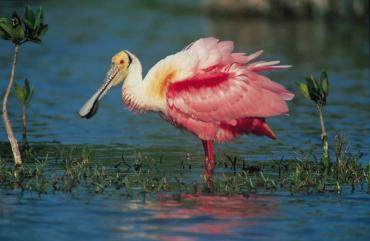Birding
Punta Gorda/Englewood Beach – The Charlotte Harbor Gulf Island Coast is a bird watcher’s paradise, with seven sections of the Great Florida Birding and Wildlife Trail within the area.
 Whether you’re a beginner just starting to document the species around your home, an experienced birder with an eagle eye (as it were), or a “twitcher” who travels great distances to observe rare species, we’ve got an avian for every Life List.
Whether you’re a beginner just starting to document the species around your home, an experienced birder with an eagle eye (as it were), or a “twitcher” who travels great distances to observe rare species, we’ve got an avian for every Life List.
While you’ll see tons of birds no matter where you go in Punta Gorda/Englewood Beach—including, if you’re lucky, the Florida Scrub Jay, the Bachman’s sparrow, and the endangered red-cockaded woodpecker—here are a few birding hotspots and some of the species you can expect to find:
Charlotte Flatwood Environmental Park
Charlotte Flatwoods Environmental Park is home to a variety of species including wading birds, great horned owls, and bald eagles. Don’t only look up around here: a diversity of reptiles and amphibians can be observed in and around the wetlands and you may also see bobcats, otters, and deer within the park.
Babcock/Webb
Explore the Fred C. Babcock/Cecil M. Webb Wildlife Management Area for a chance to see brown-headed nuthatches, American and least bitterns, king rails, sandhill cranes, sedge wrens, and many others.
This location is also your best shot to see the Bachman’s sparrow, which nests in the spring, and the red-cockaded woodpecker.
Alligator Creek Preserve
In the Charlotte Harbor Environmental Center: Alligator Creek Preserve, you’re likely to see downy and red-bellied woodpeckers and sparrows, warblers, and flycatchers along the flatwoods trail. In the marsh and hammock loop, look for wren, vireo, belted kingfishers, wood storks, and, during winter months, dabbling ducks.
Cedar Point Environmental Park
The Charlotte Harbor Environmental Center: Cedar Point Environmental Park is an established bald eagle nesting site, which means trails may be closed at certain times of the year (October through May) to protect their nests. Closures will be clearly marked and must be respected. This park also attracts snowy egrets, great blue herons, killdeers, rufous-sided towhees, and mockingbirds all year, and common loons and bay ducks in the winter.
Charlotte Harbor Preserve State Park
 The Charlotte Harbor Preserve State Park is not only the third-largest Florida State Park, it also offers opportunities to see a plethora of fascinating birds, including red-shouldered hawks, white-eyed vireos, and screech and great horned owls.
The Charlotte Harbor Preserve State Park is not only the third-largest Florida State Park, it also offers opportunities to see a plethora of fascinating birds, including red-shouldered hawks, white-eyed vireos, and screech and great horned owls.
The park also offers extensive shallow wetlands and is a great place to paddle in perfect solitude while spying wood storks, green herons, and ibis, both the white and glossy varieties.
Note: this park is full of truly remote areas and the Florida State Park site recommends visitors bring a compass, map, and plenty of water.
Tippecanoe Environmental Park
The lake in Tippecanoe Environmental Park attracts common moorhens and mottled ducks, while the tidal creeks bring in black-necked stilts and ibis. Birders who want to check Florida scrub-jays and prairie warblers off their life lists should look carefully as they walk through the flatwoods and scrub habitats.
Ann & Chuck Dever Memorial Regional Park
Exploring the two significant wetlands of the Ann & Chuck Dever Memorial Regional Park will reward birders with sightings of glossy ibis, roseate spoonbills, and snowy egrets, to name just a few species.
Two boardwalks lead to observational platforms on Lemon Lake, the better to enjoy the amazing variety of birds who inhabit the lake and the surrounding areas.
Regardless of your birding experience, getting out and about to observe and enjoy birds of all feathers is a tremendous way to spend some time, naturally!









